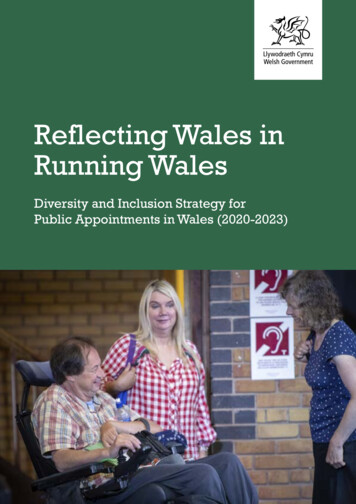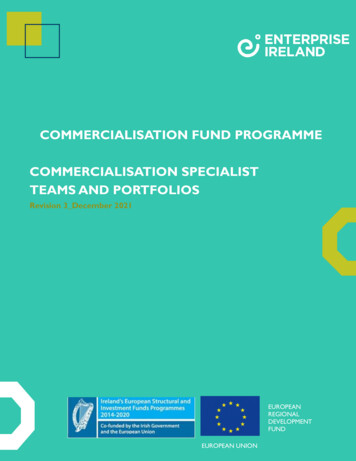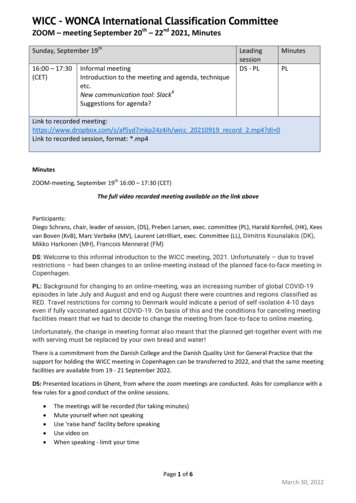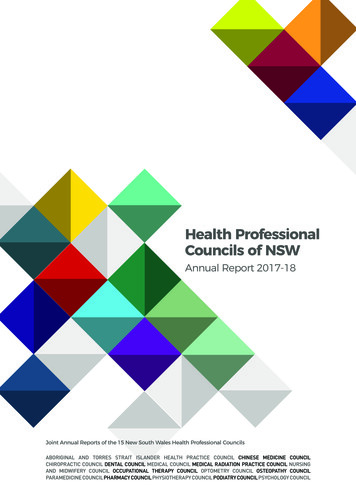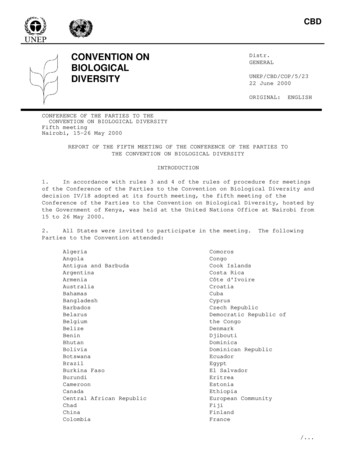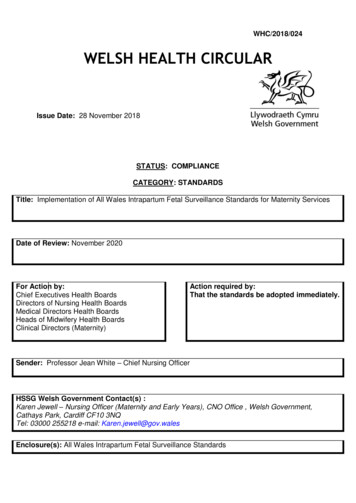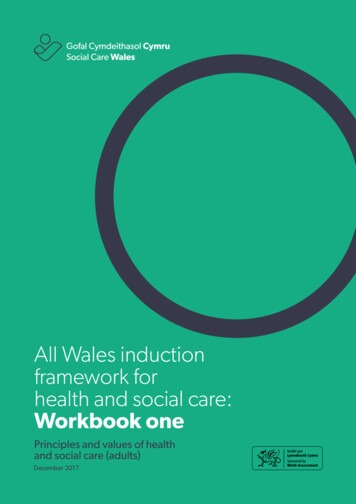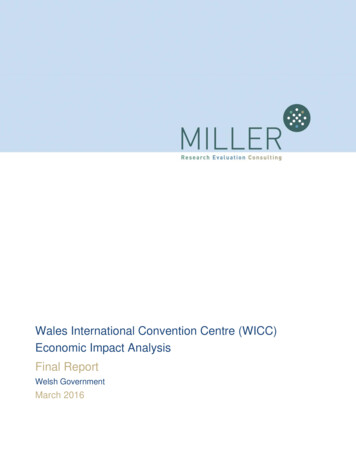
Transcription
Wales International Convention Centre (WICC)Economic Impact AnalysisFinal ReportWelsh GovernmentMarch 2016
Lead AuthorMarch 2016www.miller-research.co.uk Twitter: @miller research
Contents1Executive Summary . 42Introduction . 62.1Economic Impact Assessment: Overview . 63Context . 84Economic Contribution .114.1WICC Total Economic Contribution .114.2Construction Phase.114.3Operational Phase .134.4Extension Activity .145Additional Impacts.166Technical Approach .176.1Economic Impact Assessment: Methodology .176.2Approaches and Assumptions .216.3Calculating Average Salaries .2819/12/20163
Wales ICC1Economic Impact AssessmentExecutive SummaryEconomic Impact – Key Facts Between 225m and 429m contribution to economic activitybetween 2016-2025- Between 22m & 64m from extension activity- Between 57m & 89m from construction- Between 146m & 276m from operations Between 875 and 1,830 FTE jobs supported between 2016-2025- Between 245 and 790 from extension activity- Between 449 and 699 from construction- Between 180 & 341 from operations1 This report documents the findings of an independent economic impact assessment of theproposed Wales International Convention Centre (WICC) at the Celtic Manor Resort(CMR) which is scheduled to be operational by 1st January 2019. The Welsh Government and the CMR are working as equal partners on the proposedWICC which aims to develop a 27,000 square metre convention centre at CMR, with a4,000 square metre, 10 metres high main hall capable of accommodating 4,000 people.The proposal also includes an auditorium with fixed seating for 1,500 people, 8 rooms ofvarying sizes ranging from 40 to 800 people, and a car park with 1,000 spaces. The WICCwould cater annually for at least 30 events, generating around 90,000 room nights peryear, of which only 18,000 could be accommodated at CMR. The contribution of the WICC to the economy of Wales over the period 2016 to 2025 isestimated at being between 225 million and 429 million. This includes a total net impactof somewhere between 57 million and 89 million from the construction phase ( 29-45mfrom each year of construction); between 146 million and 276 million from the operationof the WICC and a further 22 million to 64 million from extension activity resulting fromincreased spend of delegates in the wider economy. Across the whole period, between 875 and 1,830 FTE jobs will be created by the WICCwithin Wales. Of this, around 245 to 790 will be created as a result of the operations of theconvention centre. Extension activity of delegates spending in the wider economy1, as aresult of the WICC activities is expected to support around 180 to 341 FTE jobs – around26 to 49 per year. A net present value (NPV) was calculated by using the HM Treasury’srecommended figure of 3.5% and also by accounting for the inflation effect (discountingby 2.5%). The result was that the total net economic impact of between 225 million andFor further discussion refer to the extension activity section.
Wales ICCEconomic Impact Assessment 429 million over the period 2016-2025 has a NPV of between 150 million and 286million. The CMR already has a high profile reputation as a conference venue. However, ifdeveloped, the WICC will be Wales’ only facility of its kind or scale, attracting a level ofevents which do not come to Wales or SW England at present. The facility would enable SE Wales to benefit from a level of business tourism not currentlyavailable to the region, especially from the lucrative Association Conference market.Examples of other cities where facilities have been built, such as Edinburgh and Liverpool,have shown that large convention centres can bring significant regeneration benefits totheir host communities. The impacts will come about through the construction phase, the day to day operations ofthe WICC and as a result of substantial “extension activities”; including bed nights at othersuitable hotels in the region and delegates and their spouses spending on retail, food anddrink and excursions to local attractions. The local focus of CMR spend is very strong (95% of all supplier spend occurs in Wales,mainly in the SE), therefore the multiplier effect is much greater than the Wales averagefor the hotel, bars and restaurants industry (2.19 compared with 1.54).Economic Impact of the WICC – Direct, Indirect and Induced Effects.Source: Miller Research (UK) Ltd.
Wales ICC2Economic Impact AssessmentIntroductionThis report documents the findings of an independent economic impact assessment of theproposed Wales International Convention Centre (WICC) at the Celtic Manor Resort. The aim ofthe assessment was to understand the potential impact of the increased investment and revenuethat the WICC would bring, to the Welsh economy. It is expected this report will support on-goingproposals for the WICC.This assessment builds on investigatory work already carried out for the proposal. This includesa feasibility study into its potential development, a ‘White Paper’ setting out detailed proposals forthe WICC, and a summary information document which offers updates on the proposal since theoriginal White Paper.In short, the proposals are to develop a 27,000 square metres complex comprising: A main hall of 4,000 square meters and 10 metres high, large enough to accommodateapproximately 4,000 people, A fixed seating auditorium to accommodate 1,500 people, Eight meeting rooms of varying size to accommodate between 40 and 800 people, A car park to accommodate 1,000 cars.The feasibility study recognises the Welsh Government’s announcement of Autumn 2012 tosupport the development of an international convention centre for South Wales as the catalyst forthe proposal from the Celtic Manor Resort. In addition, the Resort recognises that its currentconvention centre offer is not sufficient to meet growing demand.2.1 Economic Impact Assessment: OverviewThe WICC contributes directly to Wales’ GDP (Gross Domestic Product) through the GVA (GrossValue Added) it produces as a result of attracting conventions. This creates new jobs and resultsin demand for goods and services in the supply chain (including delegate spend in the widereconomy during their visit) and the wages paid to those people employed in businesses thatsupply the WICC. In turn this creates additional spend as the WICC’s suppliers and theiremployees consume goods and services in the wider economy.In economic terms, these impacts are defined in terms of the direct, indirect and induced effectsas explained below:Direct, Indirect and Induced Effect The Direct Effect of the WICC’s activity is its contribution to Wales’ GDP and the jobs itcreates. The Indirect Effect is the increased demand for goods and services in the WICC’s supplychain. The Induced Effect is the impact of the WICC’s suppliers and their employees spending inthe wider economy.This assessment considers the potential impact (direct, indirect and induced effects) of threedistinct phases of activity that will be delivered should the WICC proposals be realised. They are: Construction Phase – the design and build of the proposed WICC (2016 -2018)
Wales ICCEconomic Impact Assessment Operational Phase – the year on year running of the WICC (2019 – 2025) Extension Activity – the spend of delegates in the wider economy during their visit (2019 –2025)The full benefit of the activity of the proposed WICC can be estimated by calculating the economiceffects of each phase / activity. The approach taken to measuring the impact – including sourcesof information, assumptions and economic modelling used to derive the impact is discussed inAppendix 1. The subsequent sections of this report present our estimate of these impacts.In addition to the quantifiable impacts that the WICC might have, it is also expected to have animpact on wider, less quantifiable factors such as: An improvement in the profile of South Wales as a place for business, tourism, culture andleisure; Support for local facilities and initiatives such as the Newport Science Village, and the Newport2020 Regeneration Masterplan; Increase in the competitiveness in the local economy as a result of securing conventionslinked to world class research, business practices and learning.Some commentary regarding the points above is also offered in this report.
Wales ICCEconomic Impact AssessmentUnique ProspectWICC – Wales’ only International Convention Centre3ContextThe WICC White Paper sets out its business case for developing a world leading conventioncentre in Wales, capable of attracting conventions from all across the globe. It highlights that thereis no comparable facility in Wales or the South West of England, with the nearest conventioncentres being Birmingham and Bournemouth. It also identifies the drive time catchment areaindicating that three quarters of the UK population live within a 2 hour drive of the proposed site.The opportunity for the Welsh economy to benefit from the WICC by attracting business fromexisting conventions as well as generating new international business is identified in the report.Critically, the report notes that at present there are no facilities capable of hosting large scaleconventions in Wales. Present facilities, including the existing conference centre at the CelticManor Resort, are capable of hosting large conferences but not large scale conventions, whichtypically attract significantly more delegates and over longer periods (usually held over severaldays).Although the terms ‘conference’ and ‘convention’ are often used interchangeably to describesimilar events a distinction is typically made on the scale of the operation. Conferences tend tobe meetings of people who confer around a topic and although can be quite large typically do notreach the same scale as conventions – which can attract thousands of people who share acommon interest.The White Paper notes its target market for the convention centre identifying three broad types ofclients. The corporate client – who typically hold conventions as part of their annual generalmeetings, associations – the not-for-profit or public sector organisations who hold large scaleconventions and which make up 44% of all convention demand, and trade shows – which bringtogether and showcase products and services around an industry, theme or topic.It also notes that the nature of many convention organisers is to operate a rotation system ofevents where the location changes each year, to benefit members and widen their reach. As such,there is an opportunity for Wales to enter the market and capitalise on its potential by developingan international standard convention centre.The potential increase in economic activity as a result of the WICC should have particularimportance and interest to the local and regional economies because of the potential for widerspend of delegates - and those travelling with delegates, in the local area during their stay. TheWhite Paper notes a number of potential partner attractions in the locality which stand to benefitfrom the WICC. They include: Newport Museum and Gallery; Caerleon National Roman Legion Museum; Stately Homes and Castles; The Riverfront, Newport;
Wales ICC Chepstow Castle; Shopping at Newport and Cardiff; Wales Millennium Centre, Cardiff; Newport International Sports Village; Brecon Beacons National Park, and St Fagan’s Natural History Museum.Economic Impact AssessmentThe following sections set out a detailed approach to measuring an estimate of the impact thatthe WICC could potentially bring to the Welsh Economy.
Wales ICCEconomic Impact AssessmentEconomic Impact of the Proposed WICCTotal (whole period)Construction PhaseDirect ImpactNet Impact 2Output ( )Employment (FTEs)Average Annual 80M 40MLow 52M410High 80M638Low 26M205High 40M319 57M449 89M699 29M225 45M350Total Net Impact*Output ( )Employment (FTEs)Output Multiplier0.72Operational PhaseDirect Impact 147M 21MNet Impact (direct and Indirect)Output ( )Employment (FTEs) 131M167 247M315 19M24 35M45Output ( )Employment (FTEs)Output Multiplier 146M180 276M341 21M26 39M49Total Net Impact31.00Extension ActivityDirect Impact 70M 10MNet Impact (direct and Indirect)Output ( )Employment (FTEs) 18M221 54M711 3M32 8M102Output ( )Employment (FTEs)Output Multiplier 22M245 64M790 3M35 9M113Total Net Economic ImpactOutputEmploymentNet Present Value (NPV)Low 225M875 150MLow 53M285 35MHigh 93M511 62MTotal Net Impact*23Direct and Indirect effectsDirect, Indirect and Induced income effects0.31High 429M1,830 286M
Wales ICCEconomic Impact Assessment 225million to 429millionThe estimated economic impact of the WICC between 2016-20254Economic Contribution4.1 WICC Total Economic ContributionThe estimated total direct, indirect and induced impact of the proposed WICC between 2016 and2025 is between 225 million and 429 million – an annual average of around 53 million to 93million. This includes a total net impact of 57 million to 89 million from the construction phase( 29m to 45m from each year of construction); 146 million to 276 million from the operation ofthe WICC and a further 22 million to 64 million from extension activity resulting from increasedspend of delegates in the wider economy.Across the whole period, between 875 and 1,830 FTE jobs will be supported by the WICC withinWales (an average of 285 to 511 every year). Between 180 and 341 will be supported as a resultof the operations of the convention centre. During the two-year construction period, between 449and 699 FTEs will be supported in the wider economy or 225 to 350 per year. Extension activityof delegates spending in the wider economy4, as a result of the WICC activities is expected tosupport around 245 to 790 FTE jobs.A net present value (NPV) was calculated by using the HM Treasury’s recommended figure of3.5% and also by accounting for the inflation effect (discounting by 2.5%). The result was that thetotal net economic impact of 225 to 429 million over the period 2016-2025 has the NPV of 150million to 286 million.The impact for each phase of activity is discussed in turn below. 57million to 89millionThe estimated economic impact of the design and build of the proposedWICC4.2 Construction PhaseOutputAn estimated net total GDP contribution to the Welsh economy in the region of 57m to 89mwas established - based on estimates from the CMR regarding the design and construction costsfor the proposed WICC ( 79m).4For further discussion, refer to the extension activity section.
Wales ICCEconomic Impact AssessmentThis comprises an expected direct and indirect impact of 52m to 80m along the WICC’s supplychain (direct and indirect impact) plus an additional 5m to 9m from the additional induced effectof employees’ consumption in the economy.EmploymentEstimates of the employment effect of the investment suggest that a net total of 449 to 699 FTEjobs will be supported during the construction phase5, which is around 225 to 350 per year. Thisincludes all jobs supported by the spend of the main contractors on supplies, as well as the jobssupported in the wider economy from the induced spend of the employees of companiessupplying the WICC.This suggests that around 127,500 of construction output is required to support one FTE job.Sensitivity AnalysisThe economic model uses assumptions for the suitable size of deductions. The impact calculationassumes deadweight of somewhere between fifty per cent and twenty-five per cent. That is, it isassumed that no more than half and no less than a quarter of all construction activity that takesplace as a result of the build of the WICC would have happened in Wales anyway. For example,the people employed to build the WICC would have worked elsewhere in Wales, on otherconstruction projects if the WICC did not go ahead6. The true deadweight figure is unknown andso the assumed range of between fifty per cent and twenty-five per cent was chosen as the mostconservative estimate. Displacement is modelled at zero per cent for this calculation based onthe assumption that there are no other major construction projects planned during the suggestedtimeframe that would mean that the WICC prevents employees in Wales from working on otherprojects. That is, there is sufficient capacity in the construction labour market to meet the demandfor labour for the WICC. This value is assumed to remain constant in each scenario. A furtherdeduction of five per cent is included to account for optimism bias7 which is a fixed figure. Thesensitivity analysis (Table 1) suggests that the impact of construction could be as high as 121mif there was no deadweight or as low as 26m if the level of deadweight is around seventy-fiveper cent. Similarly, employment could range from as much as 949 if there was no deadweight or200 if deadweight was around 75%. The suggestion in this model is that the true impact is mostlikely to lie somewhere within the range shown as scenario’s three and four.Table 1 Construction Phase - Sensitivity Analysis – Output & ultipliersDeadweightScenario 10%Scenario 210%Scenario 325%Scenario 450%Scenario 575%Displacement0%0%0%0%0%Optimism BiasType 1 (1.27)5%5%5%5%5% 109M 97M 80M 52M 23MType 2 (1.40) 121M 108M 89M 57M 26MType 1 (1.36)866775638410182Type 2 (1.49)949849699449200Source: Miller Research (UK) Ltd.5See detailed methodology in Appendix.A detailed discussion on deductions from deadweight and other factors can be found in the chapter on detailed methodologicalapproach in the Appendix.7 That is the demonstrated tendency for evaluators to overestimate the true impact. It is a standard figure as advised by HM Treasury.6
Wales ICCEconomic Impact Assessment 146million to 276millionThe estimated economic impact of the operational phase of the proposedWICC4.3 Operational PhaseOutputsThe expected economic impact to the Welsh economy over the seven-year period of the activitiesof the WICC is estimated between 146m and 276m, an average 21m to 39m per operationalyear. This figure is calculated by estimating the amount of business that the WICC will generatefrom the delegates that it will attract - as forecasted in the White Paper8, and by modelling howthe costs that the WICC will incur in providing the services to meet the demand, will be spent. Anitemised spend profile was established for the WICC – which shows the expected WICC spendfor each year of operation, which was linked to the industry in which the spend will occur, so thatthe appropriate multipliers could be used9.EmploymentThe operational phase of the WICC is expected to support around 180 to 341 FTEs per year inthe wider economy. This includes the jobs that will be supported by the activity of the WICC in thecompanies of the supply chain of the WICC as well as the employment in companies that generateincome from the spend of people employed at the WICC.Sensitivity AnalysisThe economic model uses assumptions for the suitable size of deductions. It is largely unknownto what extent the WICC will attract new conferences that would not otherwise have taken placein Wales. Likewise, it is also unknown to what extent events at the WICC are those which wouldhave taken place somewhere else in Wales in the absence of the WICC. Given that the WICC iscreating a venue of a size that does not already exist in Wales, a proportion of events will definitelybe new to Wales. Conversely, some of the events that the WICC attracts may be events that arealready taking place at other venues across Wales. Nonetheless, an argument could also bemade that any business that the WICC takes from existing venues will subsequently be filled asother venues find alternative events to fill gaps in their schedules. Thus, in the absence of a knownvalue, this model assumes that the true proportion of new events to Wales lies somewherebetween fifty per cent and ninety per cent. It is argued that it is unlikely that the WICC will notreplace some events in Wales. Therefore, the conservative (low) estimate assumes that fifty percent of conferences that the WICC attracts would have taken place in Wales anyway. Whilst theoptimistic (high) assumption suggests that only ten per cent of events would otherwise have takenplace in Wales (that is ninety per cent are new to Wales). A sensitivity analysis was carried out toillustrate the relative impact figures based on the varying degrees of displacement discussed.This is shown in Table 2. The other deductions remain constant. The amount of deadweight isconsidered to be zero as it is argued that without intervention there would be no additional89A document produced to support the business case for the WICC.See technical Appendix for further description regarding the methodology used.
Wales ICCEconomic Impact Assessmentoutcomes. A further deduction of five per cent is included to account for optimism bias10 which isa fixed figure. For employment, a similar argument regarding displacement is adopted. That is, adegree of employment will simply be displaced (or substituted) from employment at other venuesacross Wales.Table 2 Operational Phase - Sensitivity AnalysisScenario 1Scenario 2Scenario 3Scenario 4Scenario imism Bias5%5%5%5%5%OutputMultipliersType 1 (1.96) 276M 247M 203M 131M 58MType 2 (2.21)EmploymentMultipliersType 1 (1.11) 308M352 276M315 227M260 146M167 65M74Type 2 (1.2)38134128118080DeductionsSource: Miller Research (UK) Ltd. 22 million to 64 millionThe estimated contribution to economic impact of extension activitiesassociated with WICC events between 2019 and 20254.4 Extension ActivityExtension activity relates to spend of the delegates and their spouses outside of the WICC aspart of their stay. This includes a certain amount of money that will be spent on accommodationin other hotels - as the WICC will not be able to provide accommodation for all conference /convention delegates. Further, there will also be an element of delegate (and spouse) spendoutside the WICC as part of their stay - for example on other goods such as food and drink,souvenirs etc. and services such as visits to tourist attractions and spend on travel outside of theconference (taxis, trains, to and from attractions and the airport). These additional costs havebeen modelled to provide an estimation of the overall impact of delegate spend for peopleexpected to come to the WICC.OutputThe total direct spend arising from extension activity11 associated with forecast delegate numbersis calculated to be approximately 70m between 2019 and 2025, or 10m per year going into theeconomy. Some of this expenditure will leak out of Wales as people choose to stay in hotels inEngland12 (especially considering the proximity of the WICC to the border) and some expenditureis simply replacing money that would otherwise have been spent in Wales on other things. Theresultant spend is then multiplied, as money is recirculated by suppliers within Wales. Modellingthis impact by considering scenarios (which vary the assumptions of the amount to deduct from10That is the demonstrated tendency for evaluators to overestimate the true impact. It is a standard figure as advised by HM Treasury.Wider spend associated with attending events, such as accommodation, shopping, cultural tourism and food and drink.12 This is estimated at 50%. See appendix for detailed discussion.11
Wales ICCEconomic Impact Assessmentthe estimations13) suggests that in total, extension spend translates to a net economic impactsomewhere between 22m and 64m over the seven-year period, once supplier effects and theinduced effects of employees’ consumption are taken into consideration.EmploymentIn addition, between 245 and 790 jobs are expected to be supported (FTEs) over the whole periodor 35 to 113 per year.Sensitivity AnalysisThe economic model considers the extent to which the events expected to take place at the WICCwill be new to Wales, or will simply replace events that would otherwise have taken place anyway.In the latter situation, the economic impact is not new to Wales and should therefore bediscounted. In the estimate provided above, the assumption is that fifty per cent of the events willbe new to Wales – for the same reasons as previously explained. That is, the WICC is expectedto create an event space that Wales does not currently have. It will therefore attract conferencesthat would not otherwise have come to Wales. Of course, the true value of the amount ofdeadweight is unknown and therefore a sensitivity analysis is considered – which varies theassumed level of deadweight.The model also needs to consider whether the people who attend the events are simply spendingmoney that would have otherwise been spent in Wales. This is because of the assumption thatpeople’s income is finite and if they choose to spend their money at a WICC event, then they haveless money to spend elsewhere in the Welsh economy. The most suitable method of measuringthis impact is to assume that any money spent by Welsh delegates is simply displacing moneythat would otherwise have spent in the Welsh economy. Therefore, an assumption is made, basedon the expected proportion of delegates from the hypothetical diary of events, that come fromWales. This figure is calculated as twenty-seven per cent14, therefore this proportion of delegatespend is discounted from the model as displaced expenditure. Given that an estimate of the levelof displacement can be obtained, it is held constant for the sensitivity analysis. As before, thestandard level of five per cent optimism bias is also discounted. The outcome of the sensitivityanalysis is shown in Table 3. It shows that the impact of extension activity could be as high as 65m if there was no deadweight or as low as 6m if there was 75% of deadweight. Theequivalent employment figures are 926 and 0 respectively15.Table 3 Extension Activity - Sensitivity Analysis for Output & EmploymentScenario 1Scenario 2Scenario 3Scenario 4Scenario 27%27%27%27%OutputMultipliersOptimism BiasType 1 (1.3)Type 2 (1.54)Type 1 (1.17)5% 63M 75M8335% 54M 64M7115% 41M 48M5275% 18M 22M2215% 2M 2M0Type 2 (1.3)9267905862450EmploymentMultipliersSource: Miller Research (UK) Ltd.13See technical appendix for detailed approach.See technical appendix.15 Zero FTE will be created given that the level of deductions is greater than 100%. This means that no additional jobs are supportedby the WICC than would otherwise be supported in the absence of the WICC. Thus there is no net benefit of FTE jobs supported, ifthe deadweight is 75%, displacement 27% and optimism bias 5%.14
Wales ICC5Economic Impact AssessmentAdditional ImpactsThe extent to which the proposed WICC has impacted on a number of non-quantifiable factorshas also been considered. They include: An improvement in the profile of South Wales as a place for business, tourism, culture andleisure – The WICC is expected to attract around 115,000 delegates annually, covering a widerange of associations, corporations and other interest groups. Being able to host such eventsin Wales will undoubtedly raise its profile as a place for business, tourism, culture and leisure.The CMR actively promotes its associations with a range of local and regional touristattractions to its delegates, to both increase knowledge of, and spend within the South Walesarea. Support for local facilities and initiatives such as the Newport Science Village, and the Newport2020 Regeneration Masterplan – Newport is in need of regeneration and the development ofthe WICC would significantly stimulate the local economy and will in turn lead to increasedeconomic activity. As a result, the direct and indirect effect of spend at the CMR will supportthe aims of the Regeneration Masterplan. By attracting world leading research institutes tothe WICC, the Newport Science Village will surely benefit. The association of Newport as aplace for scientific research – created by attracting such events to the WICC would have apositive knock on effect for the Science Village. Increase in the competitiveness in the local economy as a result of securing conventionslinked to world class research, business practices and learning – Previous research hasshown that the UK conference market has been forecast to grow sixteen per cent by 2020.Without an international convention centre suitable to host large scale events in Wales, theWelsh economy would entirely miss out on this growing market. By attracting such events toWales, the competitiveness of supplier companies
of the WICC and a further 22 million to 64 million from extension activity resulting from increased spend of delegates in the wider economy. Across the whole period, between 875 and 1,830 FTE jobs will be created by the WICC within Wales. Of this, around 245 to 790 will be created as a result of the operations of the convention centre.


